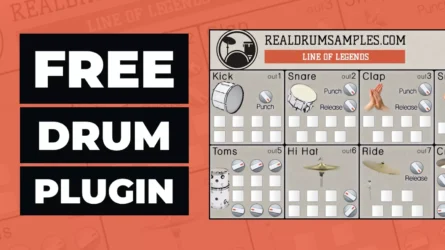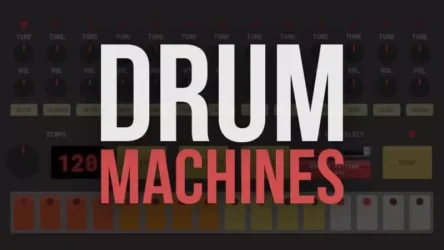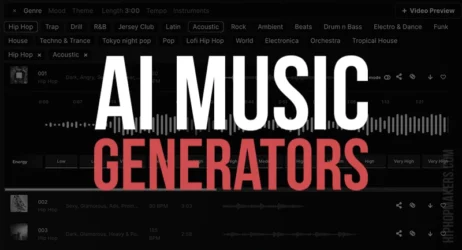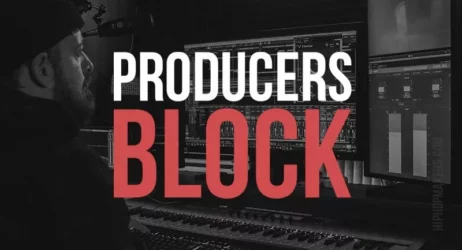This guide will answer what is Lo-Fi music, what lo-fi means, and why the Lo-Fi music genre is so popular.
- What is Lo-Fi Music
- What Does Lo-Fi Mean In Music
- Why Is Lo-Fi Music So Popular
- Who Invented Lo-Fi Music
- Why Is Lo-Fi Music Relaxing
- Who Are Popular Lo-Fi Music Artists
- How Do You Make Lo-Fi Music
- Lo-Fi Music Overview
What is Lo-Fi Music?
Lo-Fi music is a genre of music that is often characterized as gritty and grainy audio quality, with simple instrumentation. It’s calming tempo and simple drum patterns make it popular for studying and focusing online. The term lo-fi refers to unpolished music with a “low fidelity” sound.
Most Lo-Fi tracks is non-lyrical, even when it includes people’s voices, usually from old television recordings or radio broadcasts.
It has slowly been gaining popularity as a separate genre of music that is different from the typical type of music you used to listen to.
When we talk about music, low fidelity usually describes the bad audio quality, slow and repetitive tracks, often accompanied by a hiss.
It’s not bad in the usual sense. Rather it’s the good type of bad. It is a type of music that has been created to have repetitiveness arranged uniquely.
The lo-fi music genre is emerging from the underground.
It combines electronic music, downtempo music, chillwave, and indie hip-hop elements to create a pleasant mix of relaxing background beats for studying, working, reading, and other activities.
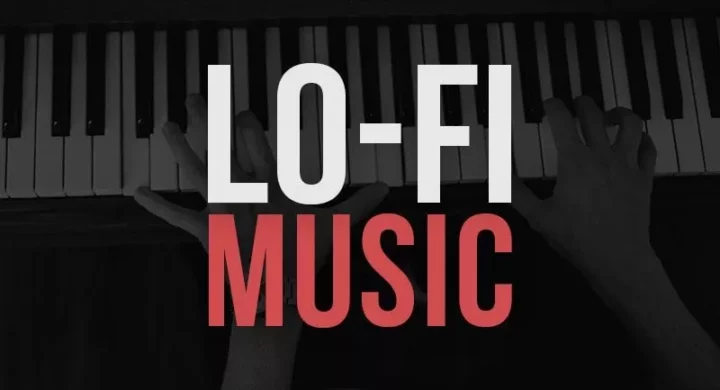
A lo-fi song usually uses drum loops or even classical music variations as sample selections.
We can define lo-fi music as chill study music, and the calming nature of this music makes it ideal study music that helps focus. Following are the several key characteristics that characterize the lo-fi sound:
Related: 20 Free Lo-Fi Samples • Free Lofi Sample Pack
Drum Loops
Drum loops are a common feature of lo-fi, just as they are in hip-hop. Drum samples produced electronically, as well as live recordings, are used in lo-fi music.
Mostly, live elements are preferred by beatmakers because they’re easier to tweak through a digital audio workshop (DAW). In general, the beats typically range from 70 to 90 beats per minute (BPM).
Jazz Chords
The relaxed, thoughtful nature of jazz chord progressions also makes them an essential component of lo-fi sounds. Lo-fi artists tend to use rhythm instruments (bass, drums) and piano in their compositions, although they may also use horns or guitar depending on the composition.
Samples
Lo-fi is typically an instrumental form of music, but many lo-fi tracks include samples and other effects to enhance music production.
It’s not uncommon to hear vocal samples, with many drawing inspiration from anime to emphasize the connection between the two mediums.
Vinyl records are also frequently used to convey nostalgia and the warmth associated with analog recordings.
Related: 11 Free Lofi Hip Hop Websites for Free Lofi Music
What Does Lo-Fi Mean In Music?
Today, lo-fi beats is mostly used as background music for virtually any type of situation — a classroom, a workplace, a relaxing environment, or just to fill the silence.
Musicians who create lo-fi tracks knowingly and intentionally damage or degrade the tape saturation to create this particular effect.
Imagine the difference between popular, mainstream hi-fi music. Music of this kind is expertly mixed and mastered to create high-quality sound effects. Meanwhile, lo-fi intends to sound raw – the opposite of hi-fi. Modern lo-fi music often draws inspiration from hip-hop songs from the 1990s and turns them into something new and original.
Why Is Lo-Fi Music So Popular?
Lo-fi Hip Hop gained popularity because of its relaxing beats. People are attracted to this genre for many different reasons – they are looking for music that reflects how they feel, how they live, and how they are experiencing their lives. Listeners can burn off stress through this music in a very positive way.
Lo-Fi’s popularity can be easily explained by looking at it through the lens of nostalgia. Lo-Fi music usually uses a lot of nostalgic elements, and it’s becoming more common. The ideal Lo-Fi helps to bring back memories of the old days.
There is no doubt that nostalgia plays an influential role in why Lo-Fi is so popular.
Who Invented Lo-Fi Music?
When it comes to lo-fi hip-hop, two names are almost always cited as the inventors or creators of the genre: Japanese DJ and producer Nujabes and American rapper and producer J Dilla. They incorporated hip-hop, jazz, and electronic music elements to create a sound that was uniquely theirs.
In 2013, live stream channels on YouTube began streaming lo-fi sounds that sparked modern lo-fi music.
Musicians with lo-fi tastes, inspired by chill-hop pioneer Nujabes and hip-hop legend J Dilla, created playlists on YouTube and other streaming services.
ChilledCow (later known as Lofi Girl), a YouTube channel that broadcasted a continuous live stream of hip-hop music in 2015, became an online radio station.
By 2017, the channel had broadcasted for nearly 13,000 hours, with 7.5 million subscribers. Today, the channel has over 9.3 million subscribers.
Why Is Lo-Fi Music Relaxing?
Lo-fi music appears to benefit its listeners almost magically because of its compounding, imperfect traits. Lo-fi Hip Hop beats are characterized by repetitive drum loops that create a feeling of comfort or nostalgia as they replace the external noise of the environment. This increases brain activity and improves concentration.
Moods are altered by slow music, which releases Serotonin, the “Happy Hormone” neurotransmitter. In addition to improved moods, lo-fi music reduces stress hormones such as Cortisol. Decreased levels of stress hormones in the blood also reduce blood pressure and irregular heartbeats.
Using Lo-Fi music to study, work out, and focus is common among students worldwide. These sound recordings contain technical flaws that can trigger the cerebrum and allow students to concentrate on their tests and homework projects.
Who Are Popular Lo-Fi Music Artists?
Today, countless lo-fi music artists are creating great music now and then. However, the following are some notable lo-fi music artists.
Chillhop Music
Chillhop Music on YouTube, based in the Netherlands, is one of the top sources of lo-fi music online. Bas van Leeuwen, the channel owner, uses his live stream as a platform for subscribers to connect and communicate while listening.
ChilledCow
Dmitri is the owner of ChilledCow, a music label and YouTube channel that started live streaming lo-fi music in 2017. In addition to his lo-fi hip-hop style, he has used a photo of a girl studying to gain mass attention. Since the image, known as Lofi Girl, has become so iconic, Dmitri decided to use the name and label for his channel in 2021.
College Music
Their CollegeMusic channel, created in 2013 by then-13-year-old UK residents Luke Pritchard and Jonny Laxton, attracted over one million subscribers, enabling them to launch their own record label. The duo’s playlist includes summer jazz, late-night beats, and other tracks that are just right for listening to while studying or relaxing.
Powfu
Isaiah Farber, aka Powfu, received a huge hit in 2020 with “Death Bed (coffee for your head),” a lo-fi hip-hop track that peaked at No. 23 on the Billboard Hot 100 chart.
How Do You Make Lo-Fi Music?
It’s pretty easy to make lo-fi music-even if it requires some jazz theory. That’s because it’s sample-based. You don’t really have to know how to play complicated chords on the piano or guitar because you can simply sample them. Nowadays, lo-fi producers fuse samples into tracks that sound like old car stereos.
Related: How to Make Lofi Hip Hop Beats in 7 Easy Steps
Making lo-fi beats is relatively easy for anyone who has access to some samples and a free DAW. We’ll look at some of the most fundamental elements behind lo-fi music.
1. Sample in a DAW
To get started, you need to learn how to sample in your DAW. For a basic start, either drop your samples directly into your DAW timeline, or you’ll use a sampling plugin to chop the samples based on their transients. Good samples are essential for this task.
Related: Best Free DAW Software Apps
2. Hip-Hop Drum Loops
Hip Hop is the base for Lo-fi music, and Lo-fi is mostly influenced by the drum production style of hip-hop from the 1990s and early 2000s. Thuddy kicks, snappy snares, and hissing hi-hats are staples of the hip-hop genre, but you don’t have to limit yourself to snares, kicks, and hi-hats.
Almost any odd percussion you can imagine can be incorporated into lo-fi music using samples of bottles, pots, and pans. While sub-genres such as lo-fi trap tend to rely on electronically produced samples, lo-fi is naturally suited to recorded samples of live percussion.
Related: Free Loops & Free Drum Loops
3. Lo-Fi Chord Progressions
Chord progressions in lo-fi are mostly just simplified jazz chord progressions. Lo-fi producers often use jazzy chord progressions like the two-five-one, along with more complex 7th and 9th voicings in their tracks. The knowledge of a little jazz theory will come in handy when searching for jazzy samples, even if you are not a musician.
4. Lo-Fi Instruments
Write lo-fi tracks like jazz composers. Jazz and low-fi are very similar- but loops are dominant in lo-fi music. So you might want to get to know jazz instruments. Drums, double bass, and piano are the most commonly used rhythm section in jazz, and these instruments should always be part of your lo-fi arrangements.
Related: Best Free Tape Emulator VST Plugins
Lo-Fi Music Overview
Lo-fi stands for “low fidelity,” a term birthed from the DIY music culture of the past, encompassing music genres from chill hop to underground indie rock bands.
Though characterized by low quality in the sense of audio imperfections, background noise, and heavy sampling of vinyl crackle, lo-fi music today presents a unique, quality music experience that’s far from being ‘low.’
Lo-fi music makes use of elements like downtempo drum loops, mellow beats, and a slower tempo, resulting in a blend of ambient music and chill-out music that can be both relaxing and invigorating.
In fact, many lo-fi songs borrow from other genres, including jazz music and boom bap, creating unique sounds that echo the past while forging a path into the future.
Most lo-fi songs have an intimate quality, as if the lo-fi musicians are right there with the music listeners, spinning their own beats.
Among the key elements in lo-fi music characteristics is the use of electronic synths, guitars, bass, piano, and drum beats.
This is highly evident in chill hop music, a style that was popularized by Japanese music producer Nujabes.
Another branch of lo-fi is ambient house, where background static becomes an integral part of the music’s atmosphere.
The DIY nature of lo-fi also means that anyone with a computer and a passion for music can produce lo-fi music.
To make your own music, simply use drum loops and distinctive samples.
Lo-fi tunes have permeated the world of YouTube creators and indie game developers, providing a soothing backdrop for creative content and gameplay.
Furthermore, hip-hop artists and contemporary lo-fi music creators have embraced the lo-fi movement, bringing their own music to the scene.
The lo-fi tracks they produce often contain a mix of high-fidelity production quality and intentional audio imperfections, demonstrating how this genre celebrates the raw, unpolished beauty of sound.
This unique aspect of lo-fi also caters to the growing demand for de-stressing music. With its ambient, mellow tunes, and slower tempos, a lo-fi playlist can provide the perfect environment to unwind, study, or even sleep.
As technology offers easier access to recording music, more and more lo-fi artists are emerging, each with their own take on what makes lo-fi music. The resulting lofi tracks, rich in both nostalgia and innovation, continue to redefine the boundaries of this genre.
If you enjoy lo-fi music or are interested in creating it, now is the perfect time to get started.
From the ambient tunes of most lo-fi songs to the innovative beats of contemporary lo-fi music, there’s something for everyone. So why not create your own beats, explore the sounds of lo-fi musicians, or simply enjoy a lo-fi playlist? With lo-fi, the possibilities are endless.
I hope you found this info on the Lo-Fi music genre helpful, and hopefully, we answered what is Lo-fi music.

